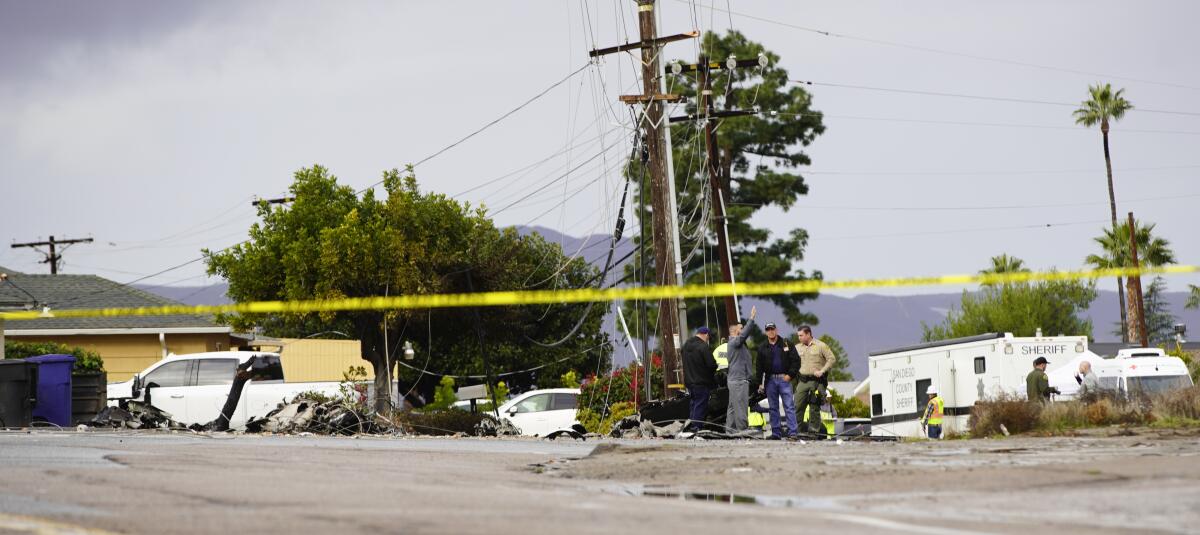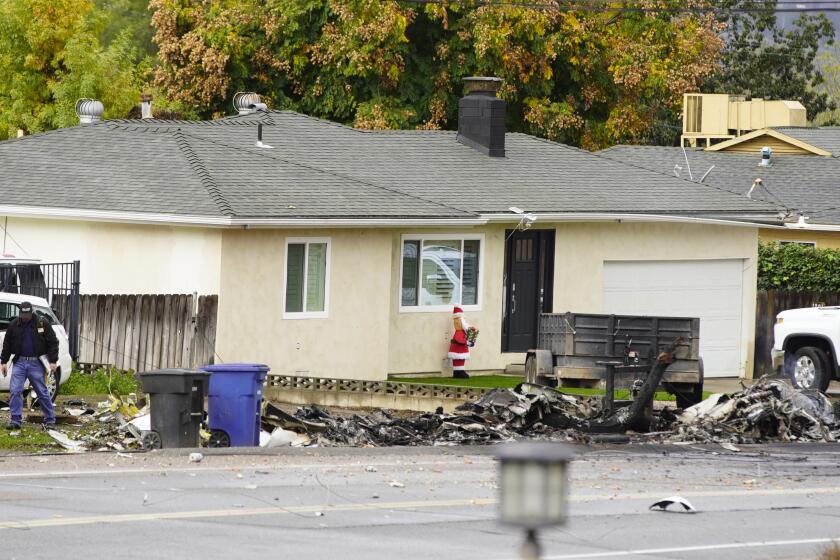NTSB report sheds light on medical transport jet crash that killed 4 near San Diego

SAN DIEGO — The National Transportation Safety Board released a preliminary report this week with new details about a plane crash in San Diego County that killed four people on a medical transport jet making an approach to Gillespie Field.
Though the report does not make a ruling as to how or why the Dec. 27 crash occurred, an aviation expert said it confirms speculation that the Learjet 35 crashed while the pilot attempted to perform a difficult maneuver at low altitude that was made more challenging by the cloudy, nighttime conditions.
The San Diego County coroner’s office previously identified the victims as pilots Douglas James Grande, 42, and Julian Jorge Bugaj, 67, and flight nurses Christina “Tina” Elizabeth Ward, 52, and Laurie Rose Gentz, 68.
The four victims appeared to work with Aeromedevac Air Ambulance, a medical transport company.
According to the NTSB report, an examination of the crash site showed the plane struck a set of power lines just before it slammed onto a street in the unincorporated Bostonia neighborhood between the suburbs of El Cajon and Lakeside. The agency said the crash occurred about 1.6 miles east of Gillespie Field.
One nearby home was damaged, but nobody on the ground was injured. The report indicated the crash left a debris path about 185 feet long and 90 feet wide.
“All major structural components of the airplane were located throughout the wreckage debris path,” according to the NTSB, which said the wreckage was moved to a secure location for further examination.
The report does not say which pilot was in control of the aircraft when it crashed, but it confirms details already known about the incident. Just before 2 p.m. that day, the crew members — who worked for the medical transport company Aeromedevac — flew from Gillespie Field to Arizona, landing at Lake Havasu City’s airport in less than 25 minutes.
A National Transportation Safety Board Aviation Accident Preliminary Report on the Dec. 27, 2021, quadruple-fatal Learjet crash on Pepper Drive.
With a medical patient on board, the plane took off about 90 minutes later and arrived at John Wayne Airport in Orange County just after 4:45 p.m. Having dropped off their patient, the Learjet crew and the nurses left John Wayne at 6:56 p.m.
At 7:12 p.m., the pilot — who had descended toward Gillespie Field heading north to south and was using flight instruments to navigate — requested a last-minute change to a visual approach on an east-to-west runway.
Aviation experts say the maneuver the pilot needed to perform to make such a landing was needlessly complicated and dangerous, requiring a sharp bank while flying low to the ground.
“There is no reason to put an airplane through [such] acrobatics. ... It is always safer and far more sensible to fly straight in instead of turn, especially at night,” said Robert Katz, a commercial pilot and flight instructor from Dallas with more than 40 years of flight experience. “The tactics were irresponsible, considering the result.”
Katz will make a presentation this month, sponsored by the Federal Aviation Administration Safety Team, examining the crash and how it could have been avoided.
Based on the information in the NTSB report, data from the flight-tracking website FlightAware and footage of the descending plane and the explosion captured on a doorbell camera, Katz said he believes the Learjet entered an accelerated stall as the pilot attempted the sharp turn back toward the airport.
“They overbanked too low to the ground to recover from an accelerated stall, in my opinion,” Katz said. “All that could have been avoided if they flew straight in.”
Katz said he’ll make his Zoom presentation in the hope “that pilots will study this and learn from it. There is a teachable moment in every one of these incidents.”
He said the crash was similar to a 1994 crash that killed four people at Fairchild Air Force Base near Spokane, Wash., involving a B-52 whose pilot was training for an air show; a 2017 Learjet crash in New Jersey that killed both pilots near the Teterboro Airport; and a July crash in Truckee, near Lake Tahoe, that killed all six people on board.
Max Trescott, a flight instructor who specializes in aviation safety and hosts the podcast “Aviation News Talk,” had also likened the crash near Gillespie Field to last year’s crash near Truckee.
“If you strip apart everything else about the [El Cajon] accident, the key is [the pilot] appears to have been very, very low for what he was doing,” Trescott told the San Diego Union-Tribune last month. “It doesn’t make sense that he would have been that low under any circumstances.”
According to the NTSB, more than 8,200 aircraft have crashed in California since July 1962, including roughly 170 in the San Diego region. Gillespie Field is listed as a destination or departure airport in 64 of those crashes.
More than 40 of the crashes related to Gillespie Field resulted in no injuries. NTSB data show 11 incidents caused 19 fatalities and nearly a dozen resulted in minor or serious injuries.
More to Read
Sign up for Essential California
The most important California stories and recommendations in your inbox every morning.
You may occasionally receive promotional content from the Los Angeles Times.












